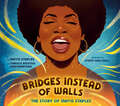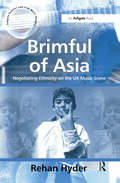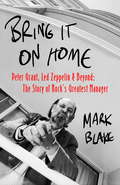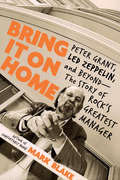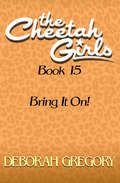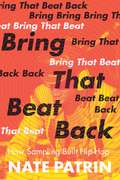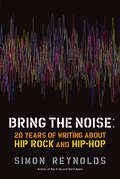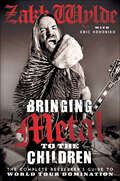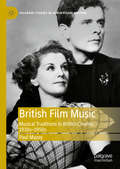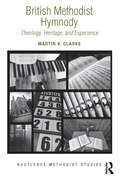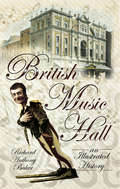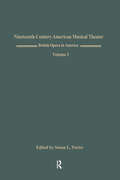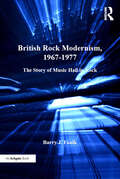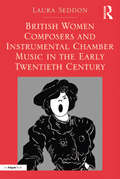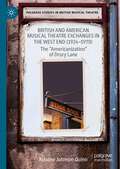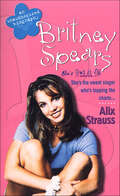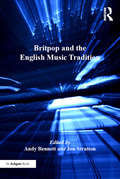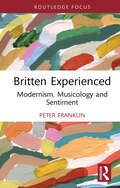- Table View
- List View
Bridge to Bat City
by Ernest ClineFrom #1 New York Times bestselling author Ernest Cline comes a mostly true tall tale about an unexpected friendship between a young girl and a music-loving colony of bats. After losing her mother, thirteen-year-old Opal moves in with her uncle Roscoe on the family farm. There, Opal bonds with Uncle Roscoe over music and befriends a group of orphaned, music-loving bats. But just as the farm is starting to feel like home, the bats&’ cave is destroyed by a big mining company with its sights set on the farmland next. If Opal and the bats can fit in anywhere, it&’s the nearby city of Austin, home to their favorite music and a host of wonderfully eccentric characters. But with people afraid of the bats and determined to get rid of them, it&’ll take a whole lot of courage to prove that this is where the bats—and Opal—belong.
Bridges Instead of Walls: The Story of Mavis Staples
by Carole Boston Weatherford Mavis StaplesLegendary singer and Civil Rights activist Mavis Staples has teamed with an award-winning children&’s poet to share her rousing life story in this spectacular picture book.At 85, Mavis Staples is still singing in front of large audiences and sharing her message of love, faith, and justice. She&’s been performing since age eight as part of her family&’s gospel group The Staple Singers, and has become one of America&’s most admired musicians, with multiple Grammys, a Kennedy Center Honor, and a place in the Rock & Roll Hall of Fame. But Mavis has been more than a thrilling singer; she has also stood alongside Martin Luther King, Jr., at numerous Civil Rights protests where her voice was a rallying cry to the country. Now she and acclaimed author Carole Boston Weatherford bring her story and her inspiring message to young people in this poetic, illuminating book, beautifully illustrated by Steffi Walthall.
Bright Lights, Dark Shadows: The Real Story of ABBA
by Magnus PalmBRIGHT LIGHTS, DARK SHADOWS. Revealed for the first time--the people who were Abba, their individual backgrounds, their musical influences and their personal demons. By the time Abba split up, no one was in any doubt that behind the glitter there was a dark side, and behind the smiling group were four troubled individuals. But even as a whole new generation of fans discovers Abba's great music, Anni-Frid, Agnetha, Benny and Bjorn have continued to remain rather shadowy, secretive figures. Their marriages, personal break-ups and superficial biographical details are well known ... but who exactly were Abba? How did Norwegian Anni-Frid, the illegitimate daughter of a German soldier, become a real-life princess? How did folksy Benny and Bjorn reinvent themselves as an international pop force to rival Lennon & McCartney? And what actually happened to blonde Agnetha who smiled a lot but never really looked happy? The author answers these and many more questions about the hit group that no one took seriously ... until everyone did. Each page is a revelation and Palm's acute understanding of the culture of his native Sweden makes these sometimes dark personal stories understandable in a unique way. Bright Lights, Dark Shadows is an instant classic, a truly great account of the rise and fall of a legendary group and a multiple biography of rare insight. . achieves the difficult feat of capturing the multiple layers of Abba ... with a deftness unusual in a rock biography." Sunday Times ".. an extraordinary book.... *Dancing Queen* will never sound the same again."
Brimful of Asia: Negotiating Ethnicity on the UK Music Scene
by Rehan HyderDuring the 1990s, Asian pop artists began entering the mainstream of the British music industry for the first time. Bands such as Black Star Liner, Cornershop, Fun Da Mental and Voodoo Queens, led those within and without the industry to start asking questions such as what did it mean to be Asian? How did the bands' Asian background affect their music? What did their music say about Asians in Britain? In this book, Rehan Hyder draws on in-depth interviews with musicians from these bands and with critics and record producers, to examine the pressures associated with making music as a young Asian in today's multi-ethnic Britain. As the book reveals, these musicians wish to convey an authentic sense of creativity in their music, while at the same time wanting to assert a positive ethnic identity. Hyder explores these two impulses against the backdrop of a music industry and a society at large that hold a range of confining stereotypes about what it means to be Asian. The experiences of these bands add considerably to the wider debate about the nature of identity in the contemporary world.
Bring It On Home: Peter Grant, Led Zeppelin and Beyond: The Story of Rock's Greatest Manager
by Mark BlakeA SUNDAY TIMES POP BOOK OF THE YEARA DAILY TELEGRAPH MUSIC BOOK OF THE YEARA DAILY MAIL MUSIC BOOK OF THE YEARA TIMES MUSIC BOOK OF THE YEAR ('Of the many Led Zeppelin biographies marking the band's 50th anniversary, this is the most illuminating')OBSERVER BEST BOOKS OF 2018'An enthralling and rigorously researched book' Sunday Times 'Blake has talked to everyone, and the stories are both lurid and melancholy' Mail on Sunday 'A juicy saga of excess all areas, Mark Blake's biography of Led Zeppelin's notoriously combative manager, Peter Grant, reads at times like an all-you-can-eat buffet of guilty pleasures . . . a riotous roller coaster' The Times 'A tale as expansive and complex as the man himself' Mojo'To say Bring It On Home is a rambunctious page-turner is an understatement; but despite all the violence and weirdness, you can't help liking the "real" Peter Grant who emerges here' Planet RockThe late Peter Grant managed Led Zeppelin to global stardom. But his life story was every bit as extraordinary and dramatic as the musicians he looked after. For the first time ever, the Grant family have allowed an author access to previously unseen correspondence and photographs to help build the most complete and revealing story yet of a man who was a pioneer of rock music management, but also a son, a husband and a father.Published to coincide with Led Zeppelin's 50th anniversary, Bring It On Home charts Peter Grant's rise from wartime poverty through his time as a nightclub doorman, wrestler and bit-part actor to the birth of rock'n'roll in the 1950s. From here, it explores his pivotal role in the formation of Led Zeppelin and charts the impossible highs and lows of life on the road with rock's most outrageous band.Bring It On Home includes almost 100 new interviews with family members, friends, musicians and rival managers, and walk-on parts for Sharon Osbourne, Bob Dylan, Stanley Kubrick, Freddie Mercury, Elizabeth Taylor, the FBI, the CIA, the Mafia - and Elvis Presley. As Grant's son Warren says now: 'My dad knew everyone.'It is the first biography to reveal the truth behind Led Zeppelin's demise, Grant's subsequent fall from grace amid death threats and the shadow of organised crime, and his final days as a man who shunned the excesses of the music industry in favour of his friends and family.With access to several previously unpublished interviews - including Grant's last and most revealing yet - Bring It On Home sheds new light on the story of rock's greatest manager and one of the giants of modern music history.
Bring It On Home: Peter Grant, Led Zeppelin and Beyond: The Story of Rock's Greatest Manager
by Mark BlakeA SUNDAY TIMES POP BOOK OF THE YEARA DAILY TELEGRAPH MUSIC BOOK OF THE YEARA DAILY MAIL MUSIC BOOK OF THE YEARA TIMES MUSIC BOOK OF THE YEAR ('Of the many Led Zeppelin biographies marking the band's 50th anniversary, this is the most illuminating')OBSERVER BEST BOOKS OF 2018'An enthralling and rigorously researched book' Sunday Times 'Blake has talked to everyone, and the stories are both lurid and melancholy' Mail on Sunday 'A juicy saga of excess all areas, Mark Blake's biography of Led Zeppelin's notoriously combative manager, Peter Grant, reads at times like an all-you-can-eat buffet of guilty pleasures . . . a riotous roller coaster' The Times 'A tale as expansive and complex as the man himself' Mojo'To say Bring It On Home is a rambunctious page-turner is an understatement; but despite all the violence and weirdness, you can't help liking the "real" Peter Grant who emerges here' Planet RockThe late Peter Grant managed Led Zeppelin to global stardom. But his life story was every bit as extraordinary and dramatic as the musicians he looked after. For the first time ever, the Grant family have allowed an author access to previously unseen correspondence and photographs to help build the most complete and revealing story yet of a man who was a pioneer of rock music management, but also a son, a husband and a father.Published to coincide with Led Zeppelin's 50th anniversary, Bring It On Home charts Peter Grant's rise from wartime poverty through his time as a nightclub doorman, wrestler and bit-part actor to the birth of rock'n'roll in the 1950s. From here, it explores his pivotal role in the formation of Led Zeppelin and charts the impossible highs and lows of life on the road with rock's most outrageous band.Bring It On Home includes almost 100 new interviews with family members, friends, musicians and rival managers, and walk-on parts for Sharon Osbourne, Bob Dylan, Stanley Kubrick, Freddie Mercury, Elizabeth Taylor, the FBI, the CIA, the Mafia - and Elvis Presley. As Grant's son Warren says now: 'My dad knew everyone.'It is the first biography to reveal the truth behind Led Zeppelin's demise, Grant's subsequent fall from grace amid death threats and the shadow of organised crime, and his final days as a man who shunned the excesses of the music industry in favour of his friends and family.With access to several previously unpublished interviews - including Grant's last and most revealing yet - Bring It On Home sheds new light on the story of rock's greatest manager and one of the giants of modern music history.
Bring It On Home: Peter Grant, Led Zeppelin, and Beyond--The Story of Rock's Greatest Manager
by Mark BlakeThe authorized biography of the most notorious rock manager of all time, Peter Grant, best known for his work with Led ZeppelinPeter Grant is the most famous music manager of all time. Often acknowledged as the "fifth member of Led Zeppelin," Grant's story has appeared in fragments across countless Zeppelin biographies, but none has explored who this brilliant and intuitive manager yet flawed and sometimes dangerous man truly was. No one has successfully captured the scope of his personality or his long-lasting impact on the music business. Acclaimed author and journalist Mark Blake seeks to rectify that.Bring It On Home is the first book to tell the complete uncensored story of this industry giant. With support from Grant's family interviews with Led Zeppelin's surviving band members, and access to Grant's extensive archive and scores of unpublished material, including his never-before-published final interview, Blake sheds new light on the history of Led Zeppelin and on the wider story of rock music in the 1960s and '70s.Full of new insights into Grant's early life as an actor, wrestler, and road manager for rock 'n' roll pioneers Chuck Berry and Little Richard; the formation of Led Zeppelin; his seclusion following the demise of the band; and his recovery from substance abuse, Bring It On Home reveals a man who, after the extraordinary highs and lows of a career in rock 'n' roll, found peace and happiness in a more ordinary life. It is a celebration, a cautionary tale, and a compelling human drama.
Bring It On: Bring It On (The Cheetah Girls #15)
by Deborah GregoryAfter winning the talent competition at the Harlem School of the Arts, the Cheetah Girls have cred uptown and down. Dorinda, the most stylish Cheetah of all, thinks they&’re finally on their way to music industry millions. But just when things are clicking for the Cheetahs, Dorinda&’s home life threatens to come apart at the seams.Dorinda lives in foster care with almost a dozen other children, and even though Mr. and Mrs. Bosco aren&’t their real parents, they&’re the only family these kids have ever known. So when a mysterious man comes demanding custody of one of Dorinda&’s brothers, she decides to fight back the only way she knows how: Cheetah style!
Bring That Beat Back: How Sampling Built Hip-Hop
by Nate PatrinHow sampling remade hip-hop over forty years, from pioneering superstar Grandmaster Flash through crate-digging preservationist and innovator Madlib Sampling—incorporating found sound and manipulating it into another form entirely—has done more than any musical movement in the twentieth century to maintain a continuum of popular music as a living document and, in the process, has become one of the most successful (and commercial) strains of postmodern art. Bring That Beat Back traces the development of this transformative pop-cultural practice from its origins in the turntable-manning, record-spinning hip-hop DJs of 1970s New York through forty years of musical innovation and reinvention.Nate Patrin tells the story of how sampling built hip-hop through the lens of four pivotal artists: Grandmaster Flash as the popular face of the music&’s DJ-born beginnings; Prince Paul as an early champion of sampling&’s potential to elaborate on and rewrite music history; Dr. Dre as the superstar who personified the rise of a stylistically distinct regional sound while blurring the lines between sampling and composition; and Madlib as the underground experimentalist and record-collector antiquarian who constantly broke the rules of what the mainstream expected from hip-hop. From these four artists&’ histories, and the stories of the people who collaborated, competed, and evolved with them, Patrin crafts a deeply informed, eminently readable account of a facet of pop music as complex as it is commonly underestimated: the aesthetic and reconstructive power of one of the most revelatory forms of popular culture to emerge from postwar twentieth-century America. And you can nod your head to it.
Bring the Noise: 20 Years of Writing About Hip Rock and Hip Hop
by Simon ReynoldsBring the Noise weaves together interviews, reviews, essays, and features to create a critical history of the last twenty years of pop culture, juxtaposing the voices of many of rock and hip hop's most provocative artists-Morrissey, Public Enemy, The Beastie Boys, The Stone Roses, P.J. Harvey, Radiohead-with Reynolds's own passionate analysis. With all the energy and insight you would expect from the author of Rip It Up and Start Again, Bring the Noise tracks the alternately fraught and fertile relationship between white bohemia and black street music. The selections transmit the immediacy of their moment while offering a running commentary on the broader enduring questions of race and resistance, multiculturalism, and division. From grunge to grime, from Madchester to the Dirty South, Bring the Noise chronicles hip hop and alternative rock's competing claims to be the cutting edge of innovation and the voice of opposition in an era of conservative backlash. Alert to both the vivid detail and the big picture, Simon Reynolds has shaped a compelling narrative that cuts across a thrillingly turbulent two-decade period of pop music.
Bringing Metal to the Children: The Complete Berserker's Guide to World Tour Domination
by Eric Hendrikx Zakk WyldeBringing Metal to the Children is a handbook to all things Heavy Metal from guitar god Zakk Wylde, of Ozzy Osbourne and Black Label Society fame.This “Complete Berzerker’s Guide to World Tour Domination” provides tips and tests for the True Rocker—as wild man Zakk Wylde and writer Erik Hendrikx invite all who dare onto the tour bus for brain-bursting tales of glory, debauchery, and general mayhem in the dangerous metal universe.From stories of backstage insanity, including intense band infighting, family arguments, and management disagreements to drunken and naked onstage antics, Wylde shares his experiences of musicianship and survival. His hilarious escapades collide with tongue-in-cheek industry advice to provide full access to the head-banging, guitar-slinging Heavy Metal lifestyle that turns the amp up to 11 on sex, drugs, and rock ‘n’ roll. “Zakk Wylde. Great Player. Great Sound. Great friend.” —Eddie Van Halen“Zakk Wylde is one of the true Heavy Metal guitar heroes of his generation. They don’t come much better than Zakk!” —Slash“If Zakk Wylde did not exist, we would have to build him like Frankenstein’s monster. The hands of Randy Rhoads sewn onto the body of Conan the Barbarian implanted with the brain of Larry David.” —Rob Zombie“When Zakk plays, it’s like Guitarmageddon!! An audio assault coming from his fret board, the true meaning of a guitar hero.” —Kerry King, Slayer“In my opinion, Zakk Wylde is the f*cking best guitarist in the world. He curses like a f*cking marine and knows more about f*cking music than anybody I’ve ever f*cking met. I hope you can use this f*cking opinion.” —William Shatner
British Film Music: Musical Traditions in British Cinema, 1930s–1950s (Palgrave Studies in Audio-Visual Culture)
by Paul MazeyThis book offers a fresh approach to British film music by tracing the influence of Britain’s musical heritage on the film scores of this era. From the celebration of landscape and community encompassed by pastoral music and folk song, and the connection of both with the English Musical Renaissance, to the mystical strains of choral sonorities and the stirring effects of the march, this study explores the significance of music in British film culture. With detailed analyses of the work of such key filmmakers as Michael Powell and Emeric Pressburger, Laurence Olivier and Carol Reed, and composers including Ralph Vaughan Williams, William Walton and Brian Easdale, this systematic and in-depth study explores the connotations these musical styles impart to the films and considers how each marks them with a particularly British inflection.
British Methodist Hymnody: Theology, Heritage, and Experience (Routledge Methodist Studies Series)
by Martin V. ClarkeHymnody is widely recognised as a central tenet of Methodism’s theological, doctrinal, spiritual, and liturgical identity. Theologically and doctrinally, the content of the hymns has traditionally been a primary vehicle for expressing Methodism’s emphasis on salvation for all, social holiness, and personal commitment, while particular hymns and the communal act of participating in hymn singing have been key elements in the spiritual lives of Methodists. An important contribution to the history of Methodism, British Methodist Hymnody argues that the significance of hymnody in British Methodism is best understood as a combination of its official status, spiritual expression, popular appeal, and practical application. Seeking to consider what, when, how, and why Methodists sing, British Methodist Hymnody examines the history, perception, and practice of hymnody from Methodism’s small-scale eighteenth-century origins to its place as a worldwide denomination today.
British Music Hall: An Illustrated History
by Richard Anthony Baker'The music hall ...had no place for reticence; it was downright, it shouted, it made noise, it enjoyed itself and made the people enjoy themselves as well.' W.J. MACQUEEN POPEMusic Hall lies at the root of all modern popular entertainment. With stars such as Marie Lloyd, Harry Lauder and Dan Leno, it reached its glorious, brassy height between 1890 and the First World War. In the first book on this subject for many years, Richard Anthony Baker whisks us off on a colourful and nostalgic tour of the rise and fall of British music hall.At the beginning of the nineteenth century people sang traditional songs in taverns for entertainment. This was so popular that rooms started to be added to inns for shows to be staged, and, before long, songs were being specially composed and purpose-built theatres were springing up everywhere. Britain's working class had, for the first time, its own form of public entertainment and its own breed of stars. The colour and vitality attracted serious writers and artists, as well as the future Edward VII, and music hall became simultaneously the haunt of the working classes and the avant-garde.Including stories of a clergyman who wrote music-hall sketches, a hall in Glasgow where luckless entertainers were pulled off stage by a long hooked pole, and Cockney dictionaries that helped Americans understand touring British performers, this book is a hugely engaging slice of social history, rich in humour, tragedy and bathos.As featured on BBC Radio Lincolnshire and in the Sunderland Echo.
British Music and Modernism, 1895-1960
by Matthew RileyImaginative analytical and critical work on British music of the early twentieth century has been hindered by perceptions of the repertory as insular in its references and backward in its style and syntax, escaping the modernity that surrounded its composers. Recent research has begun to break down these perceptions and has found intriguing links between British music and modernism. This book brings together contributions from scholars working in analysis, hermeneutics, reception history, critical theory and the history of ideas. Three overall themes emerge from its chapters: accounts of British reactions to Continental modernism and the forms they took; links between music and the visual arts; and analysis and interpretation of compositions in the light of recent theoretical work on form, tonality and pitch organization.
British Opera in America: Children in the Wood, Music by Samuel Arnold, Libretto by Thomas Morton, American Premiere Volume I (Nineteenth-Century American Musical Theater Series)
by Susan L. PorterThe series aims to represent all the major genres and styles of musical theater of the century, from ballad opera through melodrama, plays with incidental music, parlor entertainments, pastiche, temperance shows, ethnic theater, minstrelsy, and operetta, to grand opera. This series of sixteen volumes provides for the first time ever a comprehensive set of works from a full century of musical theater in the United States of America. Volume 1 presents the earliest works in this series of Nineteenth-Century American Musical Theater. Indeed, the two tides reprinted here were composed in the prior century but enjoyed a currency in the early 1800s that helped establish conventions for generations of native-born dramaturges and composers. Moreover, Children in the Wood 1795 and Blue Beard 1811 are the only two works included in this series that were fully realized abroad, and imported for performance in the United States by musicians trained in the theaters of London. As editor Susan Porter points out in her Introduction, like all stage works, they were then adapted to suit the tastes of the times and places in which they were performed. (Indeed, Blue Beard was already an English adaptation of a French work.)
British Rock Modernism, 1967-1977: The Story of Music Hall in Rock (Ashgate Popular and Folk Music Series)
by Barry J. FaulkBritish Rock Modernism, 1967-1977 explains how the definitive British rock performers of this epoch aimed, not at the youthful rebellion for which they are legendary, but at a highly self-conscious project of commenting on the business in which they were engaged. They did so by ironically appropriating the traditional forms of Victorian music hall. Faulk focuses on the mid to late 1960s, when British rock bands who had already achieved commercial prominence began to aspire to aesthetic distinction. The book discusses recordings such as the Beatles' Magical Mystery Tour album, the Kinks' The Village Green Preservation Society, and the Sex Pistols' Never Mind the Bollocks, Here's the Sex Pistols, and television films such as the Beatles' Magical Mystery Tour and the Rolling Stones' Rock and Roll Circus that defined rock's early high art moment. Faulk argues that these 'texts' disclose the primary strategies by which British rock groups, mostly comprised of young working and lower middle-class men, made their bid for aesthetic merit by sampling music hall sounds. The result was a symbolically charged form whose main purpose was to unsettle the hierarchy that set traditional popular culture above the new medium. Rock groups engaged with the music of the past in order both to demonstrate the comparative vitality of the new form and signify rock's new art status, compared to earlier British pop music. The book historicizes punk rock as a later development of earlier British rock, rather than a rupture. Unlike earlier groups, the Sex Pistols did not appropriate music hall form in an ironic way, but the band and their manager Malcolm McLaren were obsessed with the meaning of the past for the present in a distinctly modernist fashion.
British Women Composers and Instrumental Chamber Music in the Early Twentieth Century
by Laura SeddonThis is the first full-length study of British women's instrumental chamber music in the early twentieth century. Laura Seddon argues that the Cobbett competitions, instigated by Walter Willson Cobbett in 1905, and the formation of the Society of Women Musicians in 1911 contributed to the explosion of instrumental music written by women in this period and highlighted women's place in British musical society in the years leading up to and during the First World War. Seddon investigates the relationship between Cobbett, the Society of Women Musicians and women composers themselves. The book’s six case studies - of Adela Maddison (1866-1929), Ethel Smyth (1858-1944), Morfydd Owen (1891-1918), Ethel Barns (1880-1948), Alice Verne-Bredt (1868-1958) and Susan Spain-Dunk (1880-1962) - offer valuable insight into the women’s musical education and compositional careers. Seddon’s discussion of their chamber works for differing instrumental combinations includes an exploration of formal procedures, an issue much discussed by contemporary sources. The individual composers' reactions to the debate instigated by the Society of Women Musicians, on the future of women's music, is considered in relation to their lives, careers and the chamber music itself. As the composers in this study were not a cohesive group, creatively or ideologically, the book draws on primary sources, as well as the writings of contemporary commentators, to assess the legacy of the chamber works produced.
British and American Musical Theatre Exchanges in the West End: The “Americanization” of Drury Lane (Palgrave Studies in British Musical Theatre)
by Arianne Johnson QuinnThis monograph centres on the history of musical theatre in a space of cultural significance for British identity, namely the Theatre Royal, Drury Lane, which housed many prominent American productions from 1924-1970. It argues that during this period Drury Lane was the site of cultural exchanges between Britain and the United States that were a direct result of global engagement in two world wars and the evolution of both countries as imperial powers. The critical and public response to works of musical theatre during this period, particularly the American musical, demonstrates the shifting response by the public to global conflict, the rise of an American Empire in the eyes of the British government, and the ongoing cultural debates about the role of Americans in British public life. By considering the status of Drury Lane as a key site of cultural and political exchanges between the United States and Britain, this study allows us to gain a more complete portrait of the musical’s cultural significance in Britain.
Britishness, Popular Music, and National Identity: The Making of Modern Britain (Routledge Studies in Popular Music)
by Irene MorraThis book offers a major exploration of the social and cultural importance of popular music to contemporary celebrations of Britishness. Rather than providing a history of popular music or an itemization of indigenous musical qualities, it exposes the influential cultural and nationalist rhetoric around popular music and the dissemination of that rhetoric in various forms. Since the 1960s, popular music has surpassed literature to become the dominant signifier of modern British culture and identity. This position has been enforced in popular culture, literature, news and music media, political rhetoric -- and in much popular music itself, which has become increasingly self-conscious about the expectation that music both articulate and manifest the inherent values and identity of the modern nation. This study examines the implications of such practices and the various social and cultural values they construct and enforce. It identifies two dominant, conflicting constructions around popular music: music as the voice of an indigenous English ‘folk’, and music as the voice of a re-emergent British Empire. These constructions are not only contradictory but also exclusive, prescribing a social and musical identity for the nation that ignores its greater creative, national, and cultural diversity. This book is the first to offer a comprehensive critique of an extremely powerful discourse in England that today informs dominant formulations of English and British national identity, history, and culture.
Britney Spears: An Unauthorized Biography
by Alix StraussSmart, spunky, and pretty, Britney Spears is a teenage singing sensation People called "a mix of Debbie Gibson's wholesomeness and Alanis Morissette's grit." Her Baby One More Time album hit #1 on the Billboard chart right out of the starting gate. It may seem like success came overnight for this brown-eyed beauty, but she's been working at it since childhood: before joining The Mickey Mouse Club at 11, Britney was acting in commercials and in an Off-Broadway show. And at 15, the singing bug bit--and there was no stopping Britney.But behind the fame, Britney's just an ordinary teen--she loves shopping, going to the beach, eating pizza, and talking about boys. She's close to her family and is in no rush to grow up. Find out all about Britney--from her career plans to her personal life, how she gets her cool look, who she spends her time with, what it was like on the road opening for 'N Sync and much, much more.With eight pages of awesome photos!
Britney: A Life in Music (Want to know More about Rock & Pop?)
by Nadia CohenFree Britney became the clarion call for a generation of super-fans. Now read her whole story.It&’s the smile, it&’s the struggle, Britney is a teen sensation. Over 20 years in the bright lights of fame, the harsh glare of public adoration and the ever-present danger of sliding into the mocking pens of jealous critics but still she carries on. Somehow she has survived the Michael Jackson effect of early success and now commands the respect of a new generation of teens. Since 2004, she has released numerous fragrances, adding up to over 1.5 billion (yes, billion) in perfume sales and the director&’s cut version of her 'Womanizer' video is her most-watched video on YouTube, with 330 million views and counting. From Glee to X-factor, Britney is a fabulous, popular and enduring star with everyday qualities that make her fans love her and her music more and more as the years go by.
Britpop and the English Music Tradition (Ashgate Popular and Folk Music Series)
by Jon StrattonBritpop and the English Music Tradition is the first study devoted exclusively to the Britpop phenomenon and its contexts. The genre of Britpop, with its assertion of Englishness, evolved at the same time that devolution was striking deep into the hegemonic claims of English culture to represent Britain. It is usually argued that Britpop, with its strident declarations of Englishness, was a response to the dominance of grunge. The contributors in this volume take a different point of view: that Britpop celebrated Englishness at a time when British culture, with its English hegemonic core, was being challenged and dismantled. It is now timely to look back on Britpop as a cultural phenomenon of the 1990s that can be set into the political context of its time, and into the cultural context of the last fifty years - a time of fundamental revision of what it means to be British and English. The book examines issues such as the historical antecedents of Britpop, the subjectivities governing the performative conventions of Britpop, the cultural context within which Britpop unfolded, and its influence on the post-Britpop music scene in the UK. While Britpop is central to the volume, discussion of this phenomenon is used as an opportunity to examine the particularities of English popular music since the turn of the twentieth century.
Britten Experienced: Modernism, Musicology and Sentiment
by Peter FranklinWho writes the books we read about music that excites us, and why? Is ‘classical music’ all about class? Related questions underpin this partly polemical study, written by an academic who believes that the Humanities, to be really humane, must confront their methods and aims. Two recent studies of Benjamin Britten have specifically interested the author, who was educated in a world where the composer was a living subject of criticism and praise, his works reflecting values, worries and dramas that were not just about ‘music’. Franklin’s response is to question the recent writers, proposing that, like theirs, his own story conditioned when and how he experienced Britten. This he unfolds autobiographically in and around the discussion of specific works. Recalling his encounters with the composer as a schoolboy, as a student and opera-goer, and then as a teacher, he challenges recent assertions about Britten and modernism in the period.
Britten's Unquiet Pasts
by Heather WiebeExamining the intersections between musical culture and a British project of reconstruction from the 1940s to the early 1960s, this study asks how gestures toward the past negotiated issues of recovery and renewal. In the wake of the Second World War, music became a privileged site for re-enchanting notions of history and community, but musical recourse to the past also raised issues of mourning and loss. How was sound figured as a historical object and as a locus of memory and magic? Wiebe addresses this question using a wide range of sources, from planning documents to journalism, public ceremonial and literature. Its central focus, however, is a set of works by Benjamin Britten that engaged both with the distant musical past and with key episodes of postwar reconstruction, including the Festival of Britain, the Coronation of Elizabeth II and the rebuilding of Coventry Cathedral.

